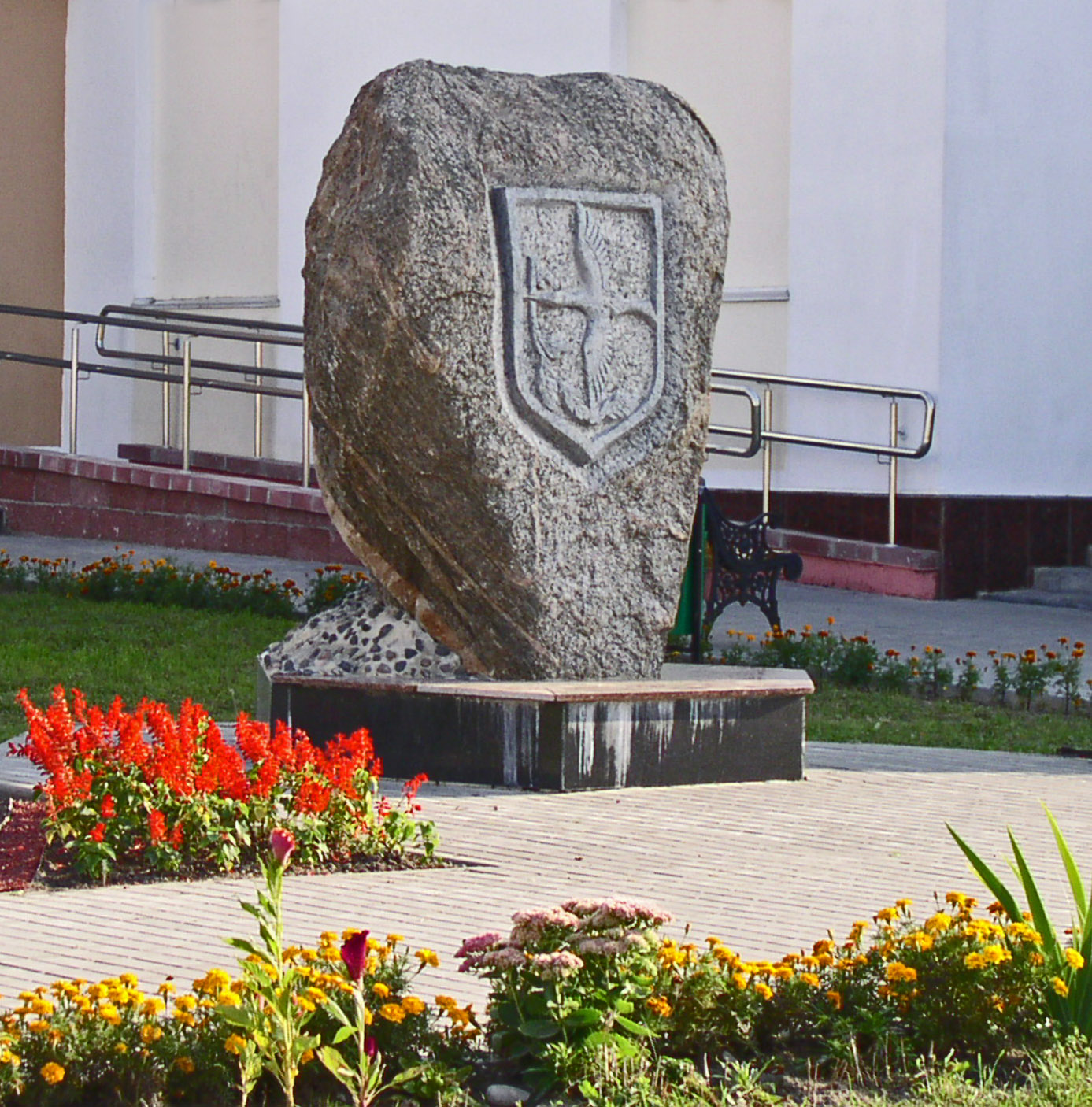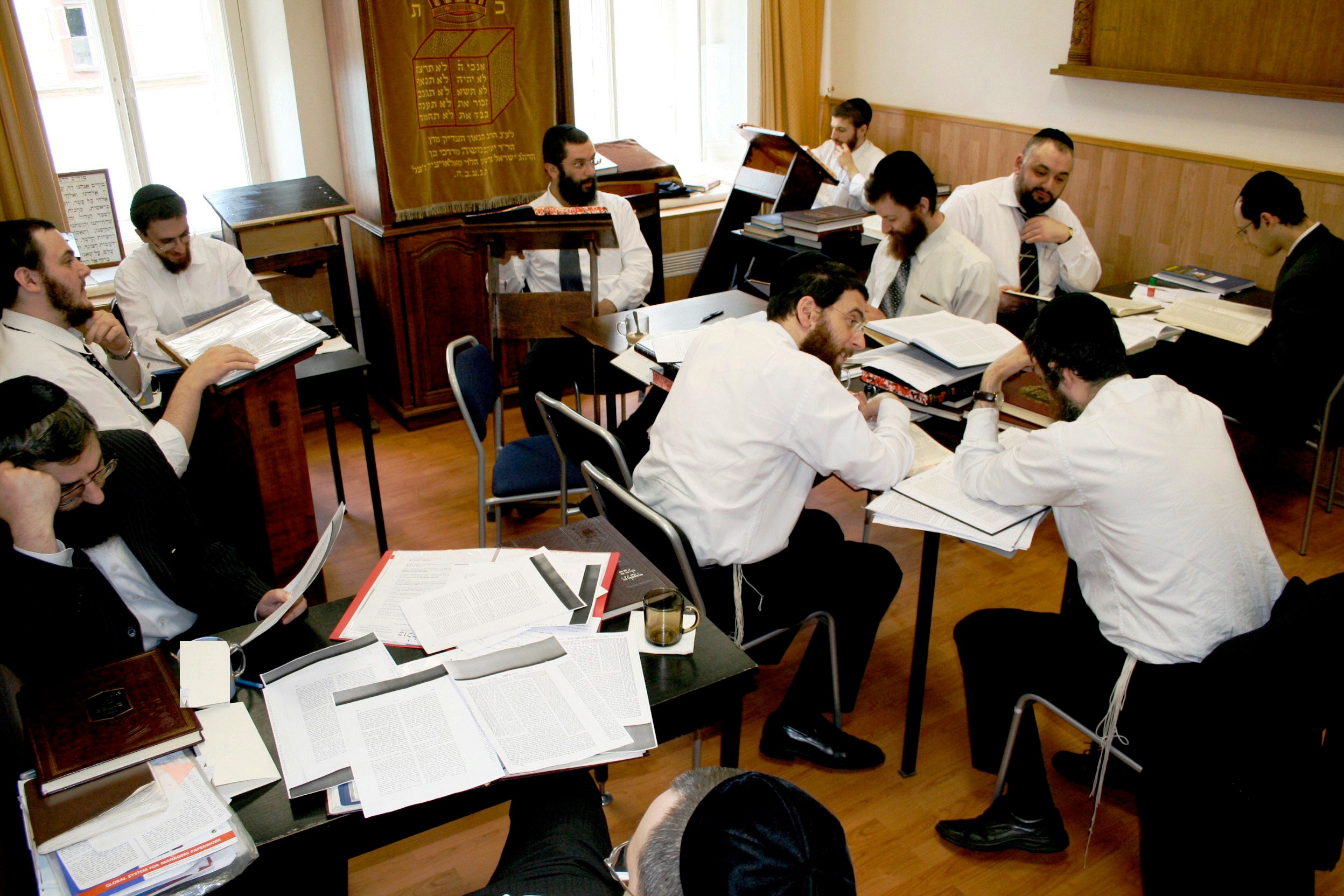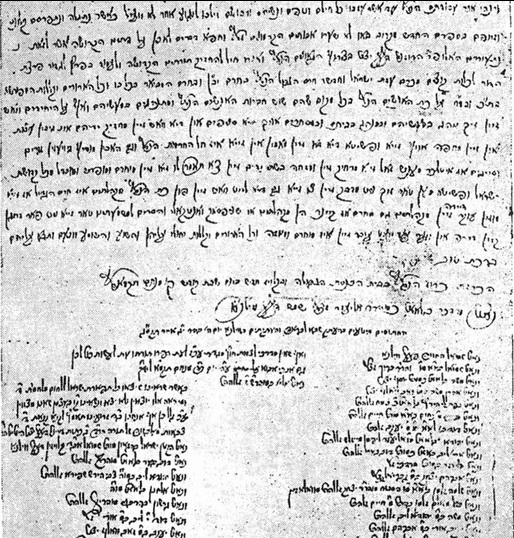|
Koidanov (Hasidic Dynasty)
Koidanov (Yiddish: קאידנאוו) is a Hasidic dynasty originating from the city of Dzyarzhynsk (Koidanov), Belarus, where it was founded by Rabbi Shlomo Chaim Perlow (1797 - 1862) in 1833. Koidanov is a branch of both Lechovitch Hasidism and Karlin-Stolin Hasidism as Rabbi Shlomo Chaim Perlow was the paternal grandson of Rabbi Mordechai of Lechovitch and the maternal grandson of Rabbi Asher Perlow of Karlin-Stolin. Koidanov was the smallest of the three Lithuanian Hasidic dynasties ( Slonim and Karlin-Stolin), with most of its Hasidim being murdered in the Holocaust. The dynasty was re-established after the war in Tel Aviv, then moved to Bnei Brak, where the majority of the dynasty is located, but there are Chassidim located around the world. History Rabbi Shlomo Chaim was the son of Rabbi Aharon Jaffe of Lechovitch who died when Reb Shlomo Chaim was a young child. After which he was raised by both his grandparents, his father's father, Rabbi Mordechai Jaffe (ca. 174 ... [...More Info...] [...Related Items...] OR: [Wikipedia] [Google] [Baidu] |
Yiddish
Yiddish (, or , ''yidish'' or ''idish'', , ; , ''Yidish-Taytsh'', ) is a West Germanic language historically spoken by Ashkenazi Jews. It originated during the 9th century in Central Europe, providing the nascent Ashkenazi community with a vernacular based on High German fused with many elements taken from Hebrew (notably Mishnaic) and to some extent Aramaic. Most varieties of Yiddish include elements of Slavic languages and the vocabulary contains traces of Romance languages.Aram Yardumian"A Tale of Two Hypotheses: Genetics and the Ethnogenesis of Ashkenazi Jewry".University of Pennsylvania. 2013. Yiddish is primarily written in the Hebrew alphabet. Prior to World War II, its worldwide peak was 11 million, with the number of speakers in the United States and Canada then totaling 150,000. Eighty-five percent of the approximately six million Jews who were murdered in the Holocaust were Yiddish speakers,Solomon Birnbaum, ''Grammatik der jiddischen Sprache'' (4., erg. Aufl., Hambu ... [...More Info...] [...Related Items...] OR: [Wikipedia] [Google] [Baidu] |
Stolin
Stolin ( be, Сто́лін; uk, Сто́лін; russian: Сто́лин; pl, Stolin; Yiddish/Hebrew: סטולין) is a town in the Stolin District in Brest Region of Belarus. It is the centre of the largest district in Brest Region. The population is 10,491 people (2012). The Belarusian-Ukrainian border is about away, so Stolin is now a border city that hosts many Ukrainians on market days. Russian speech is common here, but villagers prefer their own dialects that are akin partly to the Belarusian language, partly the Ukrainian language. History Stolin grew up at the heart of the Polesia region on the Haryn River, at the crossroads of two important routes, one leading northwards to Pinsk, two others eastwards to Davyd-Haradok and Turaŭ, that are now in Belarus, southwards to Sarny and Kyiv, that are now in Ukraine. Archaeological evidence suggests that the area which Stolin now occupies, was settled as far back as the 12th century AD. The first mention of Stolin dates ... [...More Info...] [...Related Items...] OR: [Wikipedia] [Google] [Baidu] |
Aharon Perlow Of Koidanov
Aharon Perlow ( he, אהרון פרלוב; 1839 – 1897) was the third Rebbe of the Koidanov Hasidic dynasty. He was a charismatic leader who attracted thousands of followers and effected a revival of the Koidanover dynasty founded by his grandfather, Rabbi Shlomo Chaim Perlow (1797-1862). He authored several important works that became standard texts for Koidanover Hasidim to this day, including a siddur, ''Seder Tefilot Yisrael Or Hayashar'' ("The Direct Light: Order of Prayers of Israel"). Biography Perlow was born in Koidanov (present-day Dzyarzhynsk, Belarus) to Rabbi Baruch Mordechai Perlow (1818–1870), the second Koidanover Rebbe. He was the great-great-grandson of both Rabbi Mordechai of Lyakhavichy (Lechovitch) (c. 1742–1810) and Rabbi Asher Perlow of Karlin. Before acceding to the leadership of the Koidanover Hasidim, he was the Rav of the Koidanover shtiebel in Lechovitch. He pioneered the opening of prayer houses in different towns that followed the teaching ... [...More Info...] [...Related Items...] OR: [Wikipedia] [Google] [Baidu] |
Old Yishuv
The Old Yishuv ( he, היישוב הישן, ''haYishuv haYashan'') were the Jewish communities of the southern Syrian provinces in the Ottoman period, up to the onset of Zionist aliyah and the consolidation of the New Yishuv by the end of World War I. As opposed to the later Zionist aliyah and the New Yishuv, which began with the First Aliyah (of 1882) and was more based on a socialist and/or secular ideology emphasizing labor and self-sufficiency, many Jews of the Old Yishuv, whose members had continuously resided in or had come to the Southern Levant in the earlier centuries, were largely religious Jews, who depended on external donations (halukka) for financial support. The Old Yishuv developed after a period of severe decline in Jewish communities of the Southern Levant during the early Middle Ages, and was composed of three clusters. The oldest group consisted of the Ladino-speaking Sephardic Jewish communities who settled in Ottoman Palestine in the late Mamluk and early ... [...More Info...] [...Related Items...] OR: [Wikipedia] [Google] [Baidu] |
Tiberias
Tiberias ( ; he, טְבֶרְיָה, ; ar, طبريا, Ṭabariyyā) is an Israeli city on the western shore of the Sea of Galilee. A major Jewish center during Late Antiquity, it has been considered since the 16th century one of Judaism's Four Holy Cities, along with Jerusalem, Hebron, and Safed. In , it had a population of . Tiberias was founded circa 20 CE by Herod Antipas and was named after Roman emperor Tiberius. It became a major political and religious hub of the Jews in the Land of Israel after the destruction of Jerusalem and the desolation of Judea during the Jewish–Roman wars. From the time of the second through the tenth centuries CE, Tiberias was the largest Jewish city in the Galilee, and much of the Mishna and the Jerusalem Talmud were compiled there. Tiberias flourished during the early Islamic period, when it served as the capital of Jund al-Urdunn and became a multi-cultural trading center.Hirschfeld, Y. (2007). Post-Roman Tiberias: between East and We ... [...More Info...] [...Related Items...] OR: [Wikipedia] [Google] [Baidu] |
Kollel
A kollel ( he, כולל, , , a "gathering" or "collection" f scholars is an institute for full-time, advanced study of the Talmud and rabbinic literature. Like a yeshiva, a kollel features shiurim (lectures) and learning ''sedarim'' (sessions); unlike most yeshivot, the student body of a kollel typically consists mostly of married men. A kollel generally pays a regular monthly stipend to its members. History Original sense Originally, the word was used in the sense of "community". Each group of European Jews settling in Israel established their own community with their own support system. Each community was referred to as the "kollel of " to identify the specific community of the Old Yishuv. The overwhelming majority of these Jews were scholars who left their homelands to devote themselves to study Torah and serve God for the rest of their lives. The kollel was the umbrella organization for all their needs. The first examples were Kolel Perushim (students of the Vilna Gaon who ... [...More Info...] [...Related Items...] OR: [Wikipedia] [Google] [Baidu] |
Halakha
''Halakha'' (; he, הֲלָכָה, ), also transliterated as ''halacha'', ''halakhah'', and ''halocho'' ( ), is the collective body of Jewish religious laws which is derived from the written and Oral Torah. Halakha is based on biblical commandments ('' mitzvot''), subsequent Talmudic and rabbinic laws, and the customs and traditions which were compiled in the many books such as the ''Shulchan Aruch''. ''Halakha'' is often translated as "Jewish law", although a more literal translation of it might be "the way to behave" or "the way of walking". The word is derived from the root which means "to behave" (also "to go" or "to walk"). ''Halakha'' not only guides religious practices and beliefs, it also guides numerous aspects of day-to-day life. Historically, in the Jewish diaspora, ''halakha'' served many Jewish communities as an enforceable avenue of law – both civil and religious, since no differentiation of them exists in classical Judaism. Since the Jewish Enlightenment (''Hask ... [...More Info...] [...Related Items...] OR: [Wikipedia] [Google] [Baidu] |
Shulchan Aruch
The ''Shulchan Aruch'' ( he, שֻׁלְחָן עָרוּך , literally: "Set Table"), sometimes dubbed in English as the Code of Jewish Law, is the most widely consulted of the various legal codes in Judaism. It was authored in Safed (today in Israel) by Joseph Karo in 1563 and published in Venice two years later. Together with its commentaries, it is the most widely accepted compilation of Jewish law ever written. The ''halachic'' rulings in the ''Shulchan Aruch'' generally follow Sephardic law and customs, whereas Ashkenazi Jews generally follow the halachic rulings of Moses Isserles, whose glosses to the ''Shulchan Aruch'' note where the Sephardic and Ashkenazi customs differ. These glosses are widely referred to as the ''mappah'' (literally: the "tablecloth") to the ''Shulchan Aruch's'' "Set Table". Almost all published editions of the ''Shulchan Aruch'' include this gloss, and the term "Shulchan Aruch" has come to denote ''both'' Karo's work as well as Isserles', with Karo ... [...More Info...] [...Related Items...] OR: [Wikipedia] [Google] [Baidu] |
Gemara
The Gemara (also transliterated Gemarah, or in Yiddish Gemo(r)re; from Aramaic , from the Semitic root ג-מ-ר ''gamar'', to finish or complete) is the component of the Talmud comprising rabbinical analysis of and commentary on the Mishnah written in 63 books. At first, Gemara was only transmitted orally and was forbidden to be written down, however after the Mishnah was published by Judah the Prince (c. 200 CE), the work was studied exhaustively by generation after generation of rabbis in Babylonia and the Land of Israel. Their discussions were written down in a series of books that became the Gemara, which when combined with the Mishnah constituted the Talmud. There are two versions of the Gemara. The Jerusalem Talmud (Talmud Yerushalmi), also known as the Palestinian Talmud, was compiled by Jewish scholars of the Land of Israel, primarily of the academies of Tiberias and Caesarea, and was published between about 350–400 CE. The Talmud Bavli (Babylonian Talmud) was pu ... [...More Info...] [...Related Items...] OR: [Wikipedia] [Google] [Baidu] |
Misnagdim
''Misnagdim'' (, "Opponents"; Sephardi pronunciation: ''Mitnagdim''; singular ''misnaged''/''mitnaged'') was a religious movement among the Jews of Eastern Europe which resisted the rise of Hasidism in the 18th and 19th centuries. The ''Misnagdim'' were particularly concentrated in Lithuania, where Vilnius served as the bastion of the movement, but anti-Hasidic activity was undertaken by the establishment in many locales. The most severe clashes between the factions took place in the latter third of the 18th century; the failure to contain Hasidism led the ''Misnagdim'' to develop distinct religious philosophies and communal institutions, which were not merely a perpetuation of the old status quo but often innovative. The most notable results of these efforts, pioneered by Chaim of Volozhin and continued by his disciples, were the modern, independent ''yeshiva'' and the Musar movement. Since the late 19th century, tensions with the Hasidim largely subsided, and the heirs of ''M ... [...More Info...] [...Related Items...] OR: [Wikipedia] [Google] [Baidu] |
Zlotshov (Hasidic Dynasty)
Zlotshov is the name of a Hasidic dynasty founded by Rebbe Yechiel Michel; Zlotshov or Zlotshev is the Yiddish name of Zolochiv, a town in present-day Ukraine. Known as the "Maggid of Zlotchev", Yechiel Michel (1726 - the 25th of Elul 5546/18 September 1786) was a disciple of the Baal Shem Tov, the founder of Hasidism, and of the Maggid of Mezritch. Yechiel Mechel's five sons, in turn, all founded their own branches of the Zlotshov dynasty. Descendant dynasties include the Zvhil, Skolye, Zvhil-Mezhbizh and Shotz dynasties. Rabbi Yechiel Michel Michlowitz (from Michalovce), known as the Zlotshover Rebbe of Netanya (died January 13, 2015), claimed descent from the dynasty's founder, but his exact lineage is unknown. References Hasidic dynasties {{Hasidic-Judaism-stub ... [...More Info...] [...Related Items...] OR: [Wikipedia] [Google] [Baidu] |
Ruzhin (Hasidic Dynasty)
Ruzhin (or Rizhin) is the name of a Hasidic dynasty founded by Rabbi Yisroel Friedman (1796–1850) in the town of Ruzhyn, Ukraine, today an urban-type settlement in Zhytomyr Oblast, Ukraine. Friedman was the first and only Ruzhiner Rebbe. However, his sons and grandsons founded their own dynasties which are collectively known as the "House of Ruzhin". These dynasties, which follow many of the traditions of the Ruzhiner Rebbe, are Bohush, Boyan, Chortkov, Husiatyn, Sadigura, and Shtefanesht. The dynasties of Vizhnitz and Vasloi are related to the Ruzhiner Rebbe through his daughters. History Rabbi Yisroel Friedman was a direct descendant through the male line of Rabbi Dov Ber, the Maggid of Mezritch (1704-1772), the main disciple of the Baal Shem Tov. Friedman's father, Rabbi Sholom Shachne of Prohobisht (1769-1802), died when he was six years old. He had an older brother, Avrohom (1787–1812), who became Rebbe of their father's Hasidim upon their father's death ... [...More Info...] [...Related Items...] OR: [Wikipedia] [Google] [Baidu] |




.jpg)



